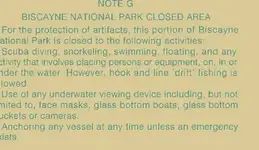Pick your poison, the Santa Margarita is a well-known "Ghost Wreck." Several versions of the same story floating around. I put a few in the "Ghost Wreck" chapter of my shipwreck book. Don't waste your time searching for, but the stories are fun to read.
1595. Spanish galleon Santa Margarita carrying between $4,000,000 and $7,000,000 in gold and silver bullion, sank twenty miles southeast of Palm Beach, Florida on July 17. (Note: Various sources place this wreck off Cutler; on the Hillsboro Rocks; off Vero Beach; off Sebastian Inlet; in Biscayne Bay; or on Florida’s west coast depending upon which source you happen to read. They Found Gold written by A. Hyatt Verrill in 1936 states “Several years ago a diver, while working on a broken submarine telegraph cable, located the galleon and found her practically intact.” The diver returned to New York to solicit funds to excavate the old galleon, but before he could return a hurricane altered the sandy bottom and when he returned, he was unable to locate the wreck. Interestingly enough an article published in the Palm Beach Daily News on November 20, 1961 reports the regent Santa Margarita Chapter of the Daughters of the American Colonists was named for “an old Spanish galleon which was wrecked off Palm Beach in 1595.” The article also claims that a cannon recovered from the wreck “now stands on the grounds of the Roscoe Tate Anthony home on South Lake Trail.”
(4,13,44,184,500,528,559,633,639,667,736,779)
1595. Spanish galleon Santa Margharita bound for Spain laden with 6,000,000 pesos in gold bullion and silver coins was lost at the entrance to Biscayne Bay. In the late 1880’s, a man found many silver bars in the mud along the shoreline near Cutler, Florida. They were believed to have originated from a Spanish galleon that sank in 1595, although the wreck has never been located.
Treasure in the Sun states the Santa Margharita was lost north of Cocoa Beach. F.L. Coffman in his book 1001 Lost, Buried or Sunken Treasure is careful to point out that this Santa Margharita should “not be confused with the ones off Palm Beach and Sebastian Inlet.” He relates a story of Ned Pent, a pilot for Miami’s Merritt Island Wrecking Company who stumbled upon a small chest in Biscayne Bay following a storm. The chest contain silver “Mexican Pillar Dollars.” Coffman surmised the coins may have originated from the Santa Margharita. (Note: While this makes for an entertaining treasure hunting story any such shipwreck from 1595 certainly would not have been carrying “Pillar Dollars.” Why? Because the use of the screw press to mint round coins with milled edges didn’t begin in the New World until after 1732. (528,559,752,779)
1597. Spanish galleon Santa Margarita sailing from Santo Domingo to Spain, richly laden with treasure, was driven ashore in the Mona Passage and wrecked near Puerto Rico. Various sources indicate the galleon carried $7,000,000 in gold, while another version states that her cargo consisted of silver bullion and specie worth $6,250,000. According to Treasure Hunting: The Treasure Hunter’s Own Book of Land Caches and Bullion Wrecks by Harold T. Wilkins, a well-known American diver was laying a submarine cable between Santo Domingo and the Bahamas when he accidentally discovered the sunken galleon. He marked the wreck, and, later on, purchased a yacht once sailed by the late Sir Thomas Lipton in the America Cup race. He returned to the site, but became a shipwreck victim himself when his yacht was severely damaged during a hurricane. A passing steamer rescued him and he was forced to leave the area having never recovered the sunken treasure. (Note: This is almost certainly another ghost wreck as I have found no archival evidence whatsoever to support any such claim. The story also shares striking similarities to the galleon Santa Margarita; allegedly lost of West Palm Beach, Florida in 1595. The above account of the “accidental” discovery of the Santa Margarita also appeared in the article “Adventures of Treasure Hunters” published in Popular Mechanics in April 1930.) (4,5,469,500,528,638,757,779)
Earlier coins minted in the New World were called “cob” coins. The word coming from the Spanish “cabo de barra,” or cut from the bar. Sliced from a roughly square bar of silver, the irregular shaped pieces were heated, struck while hot with a hammer and die with a cross and shield and trimmed to the denominations proper weight.





